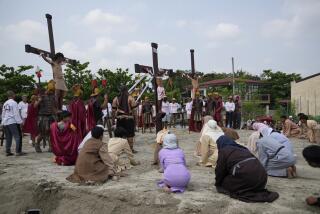Corregidor Now a Tourist Attraction to the Japanese
- Share via
CORREGIDOR, Philippines — Every year an American war veteran searches among the shell holes and debris on Corregidor Island for prayer sticks planted by Japanese tourists in honor of their 10,000 dead countrymen.
One by one, the vet casts the sticks over the cliffs into the grinding sea below.
The man is old now, but his hate still drives him to make an annual pilgrimage to the site of one of World War II’s fiercest battles, where thousands of Americans and Japanese died.
“They say they can forgive, but they can never forget what they suffered in the prison camps,” said Meliza del Rosario, for 12 years a Filipino guide on the island.
1942 Siege
Corregidor is one of four strategic clumps of rock at the entrance to Manila Bay and the Philippines capital.
In 1942, an American garrison held out against the Japanese through 27 days of bombing, shelling and invasion attempts before they were overcome.
About 5,000 Japanese and 2,000 Americans and Filipinos died in the battle.
Most of the 13,000 Americans and Filipinos on the island were shipped to prison camps in the Philippines, where an unknown number died.
The Americans returned in 1945, landing paratroops on the island’s parade ground to begin a gruesome 11-day fight against 5,000 Japanese defenders.
Only 26 Surrender
Only 26 Japanese surrendered. The rest were blown apart in deep tunnels, died in mass charges against machine guns or committed suicide with hand grenades and swords. The Americans lost 225 men.
Now Corregidor is a favored destination for increasing numbers of Japanese tourists traveling the Pacific to visit battlefields of both victory and defeat. About 30,000 Japanese came here last year.
“They like to hear about the fighting spirit of the Japanese soldiers and how they refused to surrender,” said Jose Original, 74, a Japanese-speaking Filipino guide.
He came back to Corregidor with the Americans and remembers seeing hundreds of Japanese bodies floating on the waves around its shoreline.
2 1/2-Hour Boat Trip
A group of farmers from an agricultural cooperative in Kanazawa Prefecture, south of Tokyo, recently made the 2 1/2-hour boat trip from Manila.
One or two said they were veterans of the war between Japan and China in the late 1930s, but most were too young to remember war at all.
Katuji Kikkawa, born in 1944, said his parents often talked of Japan’s futile but brave battle on Corregidor.
“Now we can go to battlefields because we have the money to travel,” he said. “I want to see these places. But it really hurts you here. It was all so stupid.”
Posing for Photos
The Japanese wandered the island, posing for snapshots beside huge rusting guns or in front of ruined barrack blocks, gouged and splintered by shellfire.
American tourists, more subdued, listened to their guide describe a direct hit from a Japanese shell on one of the batteries. It killed every artilleryman instantly and tossed huge mortars 150 yards across the golf course, now lost under a tangle of vines and trees.
Del Rosario often meets returning American veterans, including the one who carries out his annual vendetta.
“When I talk to them, I only seem to talk about sad things,” she said.
Ghostly Sounds
She recalled a 1980 reunion of 150 American soldiers. “Some just sat on the bus, crying,” she said.
After eliminating the Japanese in 1945, the American troops replanted their flag on the highest point of the island, where goats now wander and chickens scratch the dust.
More to Read
Sign up for Essential California
The most important California stories and recommendations in your inbox every morning.
You may occasionally receive promotional content from the Los Angeles Times.













